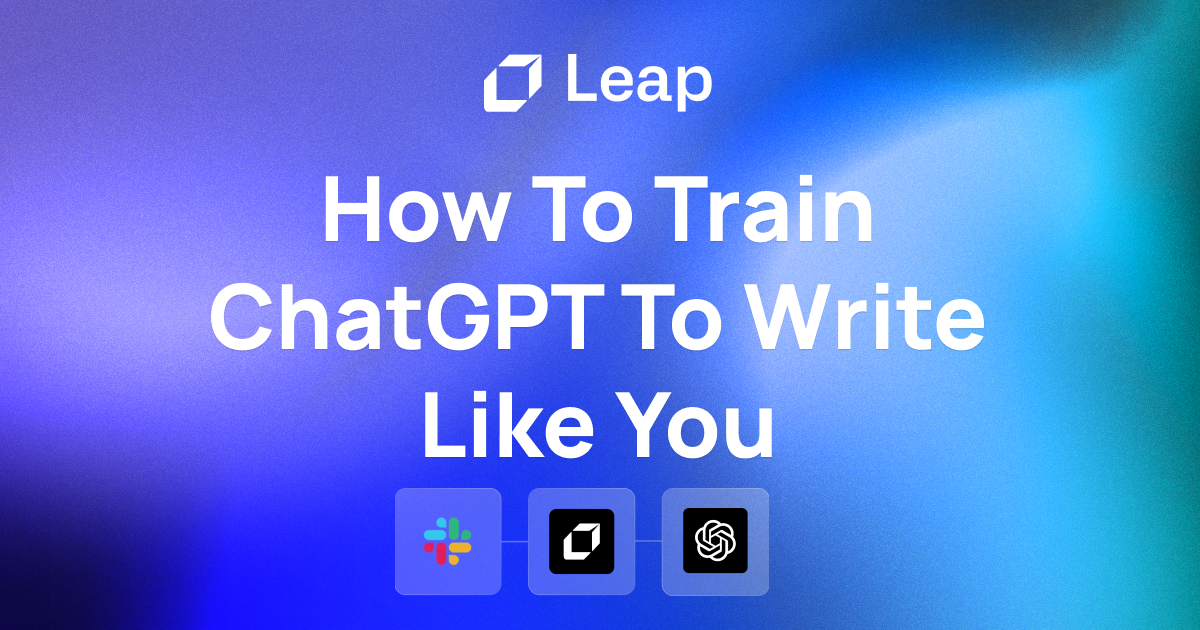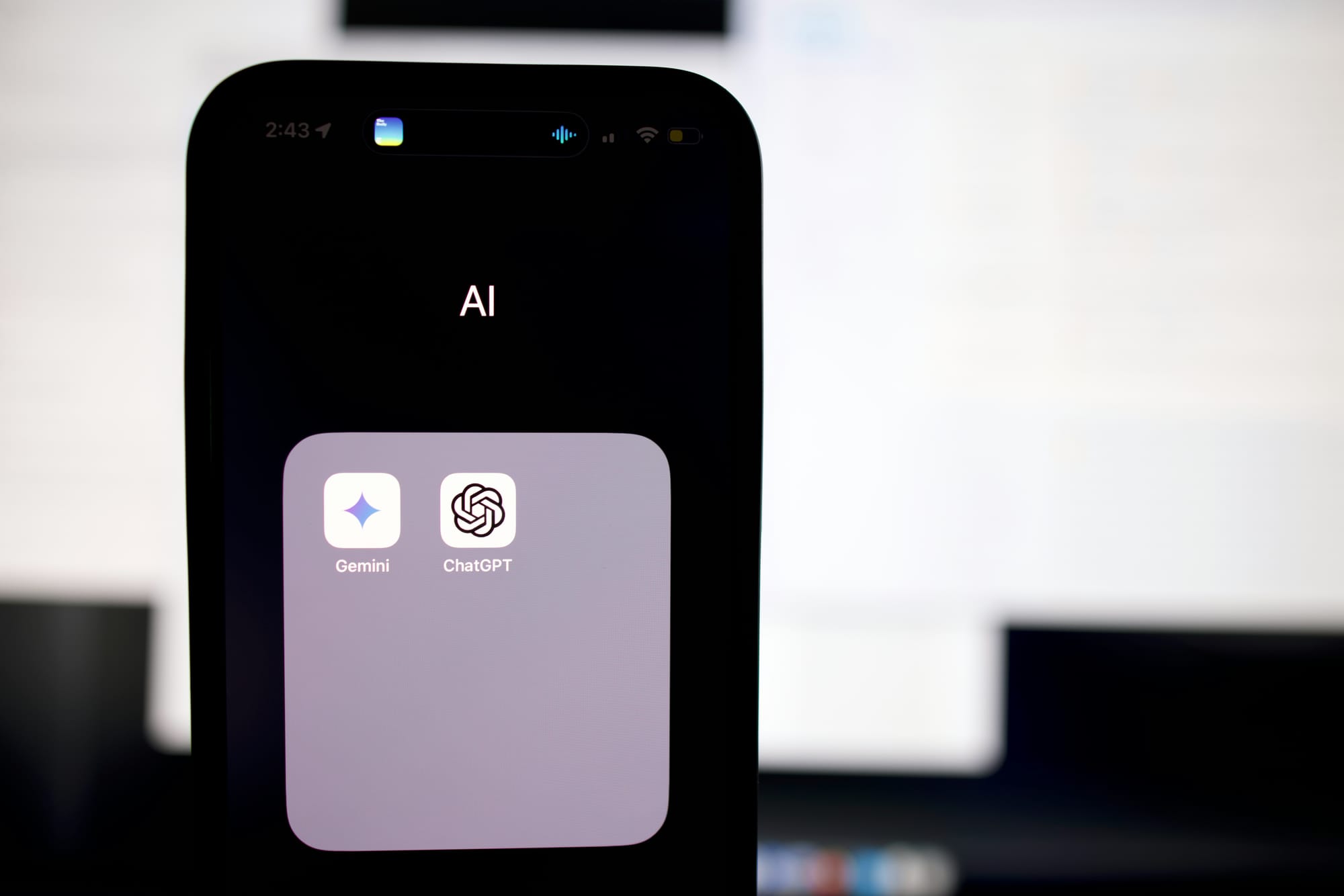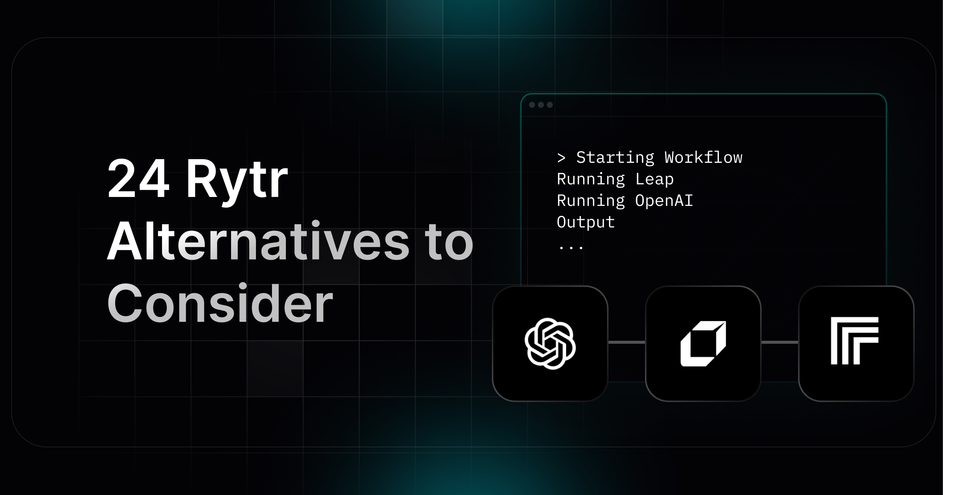How To Train ChatGPT To Write Like You in 6 Simple Steps
Learn how to train ChatGPT to write like you with this guide. Elevate your AI writing experience and achieve more personalized results.

Interested in teaching ChatGPT to mirror your writing style? This blog is all about how to train ChatGPT to write like you. Dive in for valuable tips on training your AI counterpart to generate content with just your touch. Whether you're a seasoned writer or a beginner, this blog will assist you in refining ChatGPT's output using your unique approach, making your AI assistant a dynamic tool for your content ideation endeavors.

What is ChatGPT and What is it Used For?

ChatGPT is a versatile tool that can be trained to mimic various writing styles. Its capabilities are vast and are being utilized in automation, education, coding, data analysis, and writing. The statistics tell a compelling story: as of 2024, 43% of college students and 80% of Fortune 500 companies have harnessed the power of ChatGPT for their daily operations. However, for students, if you want to skip the ChatGPT prompting, and want a ready to use solution, try this AI essay writer.
Use Cases of ChatGPT
One of the prominent applications of ChatGPT is in content creation. Imagine being able to generate high-quality content for websites, blogs, or social media platforms in just a few seconds. ChatGPT can be trained to create content such as product descriptions, blog posts, social media updates, business idea drafts, and even long-form pieces like entire articles. The applications are extensive, and the efficiency of such generation is unparalleled.
Goal of Training ChatGPT
The primary goal of training ChatGPT to write like you, whether as an individual or a brand, is to ensure consistency and a unified voice across various written endeavors. By imbuing ChatGPT with your unique writing style (AI can be awesome when it is trained, it can even analyze your color palette), it can seamlessly integrate into your content creation process, saving you valuable time and effort while maintaining the distinct voice and tone that define your work. This personalized touch enhances the authenticity of the content generated by ChatGPT and allows it to seamlessly blend in with your existing content.
Leap helps you to automate your work with the power of AI
Partnered with Zapier, Vercel, and more, Leap enables you to supercharge your work by allowing you to create custom AI automations. Create sophisticated AI automations with no-code. Connect the tools you love with best-in-class AI text, image, and audio models.
Supercharge your existing tools with seamless AI integrations to OpenAI, Microsoft, and more. From summarizing documents, to voice translation, to AI call transcription, to AI avatar and asset generation, to SEO automation, to even automating the cold email creation and sending process, automate anything with Leap Workflows. The opportunities for automation are endless with Leap workflows.
Try Leap’s AI Workflows tool for free today.

How To Identify Your Writing Style

Understanding your unique "voice" in writing is crucial to effectively training ChatGPT to mirror your style. Your "voice" is essentially the tone that you adopt in your writing. It's how you express your personality, your attitude, and your perspective on the world. If you write like you talk, your voice comes through loud and clear. If your writing doesn't sound like you, then it's time to make some changes. ChatGPT can help you evaluate your writing style, analyzing your voice, tone, and structure to give you a sense of how you come across in writing.
Analyzing Writing Style: Voice, Tone, Style, and Structure
1. Voice
Voice is the distinct personality, style, or point of view of a piece of writing. Your voice should be sincere and match who you are as a person. People should recognize your voice in your writing. As you analyze your voice, pay attention to the following questions: Do you use slang or jargon? Are your sentences long or short? Do you write in the first, second, or third person? Your answers to these questions will give you an idea of the voice you project in your writing.
2. Tone
Tone refers to the attitude you project in your writing. It's a bit more difficult to identify tone. Tone is the way you express yourself in writing. It's how you feel about the subject you're writing about. When analyzing tone, you'll want to consider the following questions: How do you feel about the subject? What is your point of view? What attitude do you project? As you answer these questions, you'll begin to get a sense of your writing style and what it says about you.
3. Style
Style is the way you express yourself in writing. When you're analyzing style, you'll want to pay attention to the choices you make in words and sentence structure. For example, do you use a lot of descriptive words? Or do you keep your sentences short and to the point? Your style is the combination of your voice and tone, as well as the specific choices you make as a writer.
4. Structure
Structure is the way you organize your writing. It's more than just the words you choose. It's how you put your writing together. For example, do you always start with an introduction and end with a conclusion? Or do you jump around in time? Do you include a lot of examples or stories to illustrate your points? The answers to these questions will help you understand what your structure says about you.
Using ChatGPT to Improve Writing Style
Using ChatGPT to analyze your writing style can help you identify patterns in your writing. When you feed ChatGPT a sample of your writing, it can analyze your voice, tone, and structure to give you a clear picture of how you come across to others. This information can help you tweak your writing to sound less robotic and more like you. The goal is for your writing to sound genuine, so when someone reads your content, they hear you talking.
Related Reading
- Content At Scale Ai Detector
- Content Marketing Roi
- Social Media Automation
- Ai Content Creation
How to Train ChatGPT to Write Like You in 6 Steps

Informing ChatGPT about My Intentions
When teaching ChatGPT to write like me, I first need to clearly lay out my intentions. In my prompt, I articulate that I want ChatGPT to mirror my writing style. I detail what this means by explaining that it involves capturing my voice, tone, and sentence structure. By providing a clear direction, ChatGPT can better understand the aim of the training session.
Sharing Writing Samples
I share examples of my writing with ChatGPT. This step is crucial as it allows ChatGPT to familiarize itself with my writing tone, voice, and structure. The examples I provide serve as a reference point, enabling ChatGPT to capture the essence of my writing style accurately.
Labeling My Writing Style
To simplify the learning process, I assign a distinct label to my writing style, such as "KK Style." This label helps ChatGPT understand that it's learning to mimic a specific writing style. I then ask ChatGPT to summarize my style based on the writing samples I've shared.
Defining Key Elements
I break down my writing style into four key components: voice, tone, style, and structure. By clearly defining each element, I help ChatGPT understand how I sound on the page, the attitude I convey, the language choices I make, and how I organize my content. This detailed breakdown guides ChatGPT in accurately replicating my writing style.
Customizing Instructions
I make use of ChatGPT's custom instructions feature to program it to write in my style. By providing background information and requirements, I guide ChatGPT on how to generate content that aligns with my unique writing style. These custom instructions help ChatGPT understand what's expected of it when producing content in my writing style.
Experimenting and Refining
After training ChatGPT, I experiment with different prompts and content types. This experimentation stage allows me to refine ChatGPT's output further. I tweak my writing style descriptors or prompts as needed to fine-tune ChatGPT's output and achieve a closer match to my voice.
How Long Does It Take To Train ChatGPT to Write Like You

The complexity of my writing style, the volume and variety of content provided, the level of fine-tuning required, the consistency in feedback and iteration, and the specificity of instructions all play pivotal roles in the time it takes to train ChatGPT to replicate my writing style effectively.
Complexity of My Writing Style
The intricacies of my voice, tone, style, and structure are critical components that influence the training duration. A more nuanced and elaborate writing style may demand more time for ChatGPT to accurately capture and replicate its essence. The complexity of my writing style influences how quickly ChatGPT can learn and adapt to mimic my unique voice and tone effectively.
Amount of Content Provided for Training
The quantity and diversity of content samples shared with ChatGPT during training can significantly impact how efficiently the model understands and replicates my writing style. By providing a substantial amount of varied content, ranging from blog posts to social media captions, I can enhance ChatGPT’s ability to mirror my writing style effectively. More content allows ChatGPT to gain a comprehensive understanding of my unique writing nuances, leading to a quicker training process.
Level of Fine-Tuning Required
The extent of fine-tuning needed to achieve the desired output also influences the training duration. If my writing style demands detailed adjustments in voice, tone, or structure, more time may be necessary to refine ChatGPT’s responses until they closely match my style. By focusing on and fine-tuning specific elements of my writing style, I can expedite the training process to ensure ChatGPT accurately reflects my unique voice and tone.
Consistency in Feedback and Iteration
Regular feedback and iterative refinement of ChatGPT’s output are essential for training success. Consistent monitoring, adjustments, and testing of generated content can expedite the training process by quickly identifying areas that need improvement and guiding ChatGPT towards a more accurate representation of my writing style. This ongoing feedback loop helps ChatGPT learn and adapt more effectively, reducing the overall training time required.
Specificity of Instructions
The clarity and specificity of the instructions provided to ChatGPT can have a significant impact on training time. Clear, detailed prompts that outline my expectations, preferences, and writing style characteristics can streamline the training process by guiding ChatGPT effectively and minimizing the need for extensive revisions. By providing precise instructions and examples, I can accelerate the training process and ensure ChatGPT accurately captures my writing style.
Related Reading
- Content Scaling
- Content Automation
- Content Workflow
- Content Marketing Automation
- How To Make Ai Content Undetectable
- Content Marketing Workflow
- Best Instagram Automation
- Ai Powered Content Creation
- Ai Content Optimization
- Content Planning For Social Media
- Ai Content Management
- Ai And Content Marketing
- Content Production Process
- How To Automate Content Creation
- Automate Blog Posts
- Cost Effective Content Marketing
What Are Some Benefits of Training ChatGPT to Write Like You

Personalized Content Creation
Creating content that is unique to you is crucial. ChatGPT can assist immensely in amplifying your voice, tone, and style, making your content resonate with your audience more effectively. It adds a layer of authenticity and makes the content relatable.
Time Efficiency
Utilizing ChatGPT can be a game changer for time management. It can significantly reduce the time spent on revisions, as it provides real-time feedback. This is especially helpful for those who have to deal with multiple tasks like students and writers.
Consistent Brand Voice
When operating a business or brand, maintaining a consistent voice across all platforms is essential. By training ChatGPT to write in your style, you ensure that all your content aligns with your brand's identity. It helps reinforce your brand's message and identity, thereby creating a cohesive online presence.
Increased Productivity
Employing ChatGPT to write in your style can significantly boost productivity. It allows you to automate content creation tasks, leaving you with ample time to delve into more strategic activities. Freeing yourself from the writing process can increase your focus on higher-level strategies.
Enhanced Writing Skills
ChatGPT can also be a valuable tool for students looking to enhance their writing skills. By providing a non-judgmental environment, it helps students practice drafting, evaluating, editing, and revising their work. This can be a great way to build essential writing skills.
Support for Multilingual Content Creation
ChatGPT can be a lifesaver for creating multilingual content. It aids in maintaining consistency across different languages, making it easier for brands targeting a global audience. With ChatGPT, you can ensure that your unique voice remains consistent, even when content is translated into various languages.
Creative Exploration and Experimentation
Using ChatGPT provides an opportunity for creative exploration. It serves as a safe space to experiment with different writing styles, tones, or genres without starting from scratch. This can lead to the discovery of new and engaging ways to connect with your audience.
Create Game Changing Automations Today With Leap’s AI Workflows
To train ChatGPT to write like me, you will need to strategically leverage AI workflows. Leap enables you to supercharge your work with custom AI automations, seamlessly integrating tools you love with best-in-class AI text, image, and audio models such as OpenAI and Microsoft.
The process is simple: from summarizing documents to voice translation, AI call transcription, AI avatar and asset generation, SEO automation, and even automating cold email creation and sending, you can automate anything with Leap Workflows. The possibilities for automating your work are truly limitless with the versatility and power of Leap. With Leap's AI Workflows tool, you can effortlessly train ChatGPT to write in your unique style efficiently and effectively.
Try Leap's AI Workflows tool today, and revolutionize the way you work forever.
Related Reading
- Midjourney Alternatives
- Ai Content Creation Tools
- Best Linkedin Automation Tools
- Social Media Automation Tools
- Content Automation Tools
- Writesonic Alternative
- Copy Ai Alternatives
- Jasper Ai Alternative
- Rytr Alternatives
- Wordtune Alternatives
- Ai Content Generator Api
- Content Automation Services
- Frase Alternative




